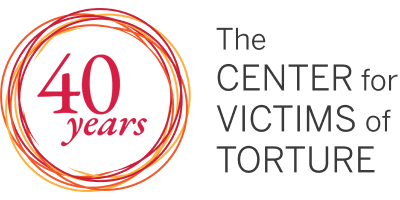Mary Healy is a veteran CVT volunteer
Last week, a client who is a survivor of torture called me, ecstatic about her most recent accomplishment: she took the bus to a place she had never been, all by herself. For someone who is still learning English, it was an amazing milestone to hear from her. I remembered how scared she was to get on an escalator when I first volunteered to help her get around, and now she’s able to navigate the transit system on her own.
CVT is founded in hope, and I equate her confidence with her ability to hope.
I learned about CVT in the mid-1990s, when I went on a fundraising garden tour. I enjoy nurturing the beauty and frequent surprises of my own garden, and am inspired by the order and design of others. On the tour, I picked up a brochure describing the work of CVT helping torture survivors on their healing journeys, and knew I wanted to contribute.
I started in the New Tactics for Human Rights program, designing a database because my background is in IT. Then I became a befriender, helping a young mother navigate grocery stores. My true mission, however, is being a bus tutor: a volunteer who helps clients navigate the transit system.
My first meeting with a client is at the St. Paul Healing Center with an interpreter and a social worker. I ask where the client would like to go, and we agree on a date for our first practice ride. Medical appointments, clothing sources and food shelters are common destinations for clients, but sometimes they’ll share that they want to go grocery shopping or visit a friend. I use the Metro Transit web site to prepare our trip plan. If the client can read English, I give her a printed copy of the plan. If she doesn’t read English, I use Google Maps to prepare a story board with images of landmarks.
While language can be a challenge, another major challenge is the Minnesota climate. Many clients come from much warmer climates. We’ll take out donated hats, jackets and mittens, and I’ll make sure they are dressed appropriately before we leave on our route. I carry some loaner mittens and socks to be sure the clients have what they need to be comfortable. One time, a client needed to get to her medical appointment, and it was 10 degrees outside. I drove to her place, and I thought about driving her to the appointment, but I knew I needed to prove to her that taking the bus in winter is possible. We made our trip, and on the last walk from the bus stop to her home, it started to sleet and the wind picked up. It was hard to breathe the cold air. We couldn’t run or we’d slip, so we started powerwalking, stopping every now and then to turn our faces away from the wind. When we finally made it inside, she ran to the closet and grabbed many blankets for both of us. We plopped on the couch and laughed in triumph, because it had been such an uncomfortable and difficult walk home, and we made it. We had known there was nothing else to do but to move forward, and we knew we’d get back to a warm apartment.
I believe CVT’s volunteer program succeeds because it’s based on respect. Volunteers aren’t mentors, we are local guides sharing our experience. Because our time and energy can help clients with simple practical needs, CVT staff is able to focus on more specialized areas of their help. As a CVT donor, I appreciate that my monetary contributions can be efficiently focused this way.
My advice to other volunteers is this: when you’re working with clients, think about the times you traveled to another city or country and wanted to get around. It would be nice to have a relative who would meet you and give you some tips. Offer that same hospitality to clients. Befrienders can also be thought of as community guides because we are guides to the communities we live, work and play in. Our warmth can make clients feel supported as they navigate unfamiliar terrain. We help alleviate some of the isolation and loneliness that many clients feel.
In the 15 years I’ve been a CVT volunteer, I’ve helped dozens of clients navigate the bus and lightrail systems. Each client has her own unique and compelling story. We approach the bus ride as an adventure. We practice together. We laugh and make mistakes together. They build trust and confidence in their journeys with me. Every client I work with expresses sincere appreciation for my help, and often they also regret that they can’t do something for me in return. I tell them that they’ll have a chance to help someone else in the future. This seems to resonate with them deeply.
Though I usually do not know the details of clients’ pasts, each person I meet makes me more conscious of the turmoil and challenging political situations in so many parts of the world. Clients long for better times in their home countries. Sometimes this feels overwhelmingly discouraging. Right now, though, they are here, and together we explore how we can make Minnesota feel like home. From sharing the thrill of the ferris wheel at the State Fair to the peaceful environment at the Como conservatory, we appreciate our common humanity.
My garden grows. My grandchildren grow. And I like seeing the same with clients—that they flourish.
CVT gives thanks to the extraordinary 200+ local volunteers who donated more than 9,600 hours of their time in 2015, to help survivors with tutoring, rides, using public transportation and offering friendship and support. Learn more about how you get involved as a volunteer.
